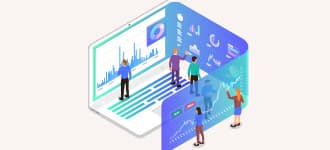In today’s data-driven era, data is being generated at an unprecedented rate. As the data landscape evolves, it has become important to leverage accessible ways to view and understand data. Data visualization comes to the rescue in such situations.
Data visualization is pivotal in making sense of all this information and turning it into actionable insights. Considering the current pace, the global data visualization market will grow at a CAGR of 9.69% from 2020 to 2027.
As big data and technology industries continue to grow and evolve, customized reports and dashboards will become integral to businesses, implying increasing demand for data visualization professionals.
What is Data Visualization?
Data visualization means transforming data from numbers and figures into a beautiful visual representation, making the data more understandable. The tool assists businesses in identifying factors affecting customer behavior, indicating areas that require improvement, and making data more memorable.
Benefits of data visualization include:
- Simplifying large and complex data: Data visualization creates small ‘packages’ (units of information) to convey ideas that can be stored in your viewer’s short-term memory.
- Accelerate decision-making process: Decisions may be made more quickly with data visualization, and viewers can see patterns and trends much more clearly.
- Discover hidden patterns and outliers: With data visualization, businesses can discover trends, patterns, and relationships that are not easily discernible from numerical data.
Also read: PGCP in Data Science & Machine Learning (PGCP-DSML)
Who is a Data Visualization Specialist?
Data visualization specialists are professionals who can represent raw, scientific data as images and provide a clear and intuitive approach to processing big data analytics.
The key responsibilities of a data visualization specialist are:
- Generating visual depictions of text-based or numeric data to reveal patterns, trends, or correlations between different points
- Creating dashboards to showcase information
- Creating and editing visual content such as maps, charts, scatter plots, and graphs
- Helping decision-makers gain an overview of patterns, trends, and insights and draw actionable conclusions
Skills and Qualifications
A bachelor’s degree in information technology, computer science, data analysis, computer science, data science, statistics, or mathematics is recommended for pursuing a career in data visualization. A master’s degree or a certification course in data visualization can get you better, higher-paying jobs.
Technical skills required for a Data Visualization Specialist
- Proficiency in data visualization tools – As a data visualization scientist, it is very important to select the right software tools (Tableau, Power BI, etc.) to highlight the objectives best when presenting data.
- Knowledge of data manipulation and cleaning techniques – Ability to detect outliers and remove multicollinearity.
- Understanding of design principles and aesthetics – Ability to select the right color and contrast to enhance your visual content and eliminate obscure visual elements.
Analytical and communication skills required for a Data Visualization Specialist
- Strong storytelling and presentation skills – Drafting a compelling narrative using storytelling.
- Ability to analyze complex data sets and identify key insights – Proficiency in data analytics, recognizing patterns, and developing audience understanding.
- Collaboration and teamwork abilities – Coordinating with a team to refine and streamline the process.
Industry Applications
From healthcare and finance to hospitality, professionals work with data visualization scientists to gain important data insights. Here are a few real-world examples of data visualization use cases:
- Healthcare: Data visualization finds use in analyzing costs and claims, clinical information, understanding patient behavior, and pharmaceutical information. Example: Apollo Hospitals, for example, use a combination of data analytics and visualization to work on their HIS (Hospital Information System).
- Retail: Data visualization can provide insight into customer behavior. It can help businesses better anticipate customers’ demand and supply products accordingly. Reliance Group formed a private cloud with a visualization technique (tableau) to gain a competitive edge for its entertainment arm – Reliance Games.
- Finance: Data visualization tools can help forecast market fluctuation in the stock market, develop instant products, and present a clearer picture of your cash flow. For example, ICICI Bank uses data visualization to facilitate better targeting and product alignment.
Also read: Role of Data Science in Stock Market Trading
Customized data visualizations can provide a tailored view of a specific topic based on the industry’s requirements. It involves modification of the dashboard per individual preferences and requirements.
Career Prospects for Data Visualization Specialists
The data visualization industry is expected to grow steadily and provide competitive salaries while ensuring good career advancement. An associate degree may be helpful, but a master’s or doctoral program can provide even more opportunities to achieve supervisory roles and better pay.
Data Visualization Specialist roles include the following:
- Data Visualization Specialist
- Data Scientist
- Business Intelligence Analyst
- Data Engineer
Also read: Master’s in Data Science: Key to UAE’s data economy
Data visualization is a skill that demands constant upgradation. To continuously sharpen your lifelong learning as a data visualization scientist, check out the MSC in Data Science program by MAHE.
Remuneration and Salary Range
The average yearly Data Visualization Specialist salary in India is 6.0 Lakhs, with salaries ranging from 2.1 Lakhs to 17.0 Lakhs. The salary for these professionals is mainly based on their qualification level, work experience, and data processing, analysis, and presentation abilities.
| Job Title | Average Annual Salary |
| Data Visualization Scientist | ₹ 8,00,000 |
| Data Visualization Engineer | ₹ 9,76,133 |
| Data Visualization Analyst | ₹ 6,02,784 |
The benefits and perks commonly associated with a data visualization role:
- Always high in demand
- Scope for career advancement
- High earning potential
Challenges and Best Practices
Managing data complexity and volume is the biggest challenge in data visualization. However, professionals can overcome these difficulties by managing incoming data quality, avoiding data duplication, and ensuring referential integrity.
Here’s how to protect data against misuse:
- Having a robust data governance policy addresses this data privacy challenge.
- An effective data governance program assures your organization the confidence to make data widely accessible yet secure.
- Always use tools with end-to-end encryption, authentication, authorization, and backup features.
The best practice for effective data visualization and storytelling is focusing on four elements of effective storytelling:
- Character – Target audience
- Setting – Current scenario (such as a drop in sales figures)
- Conflict – Identifying the root cause (such as product price or packaging)
- Resolution – Propose a solution
Also read: The impact of business storytelling in the digital world
Tools and Resources
Here are some commonly used data visualization tools:
- Tableau: Allows users to create visually appealing and highly interactive reports and charts.
- Infogram: A visualization tool for social media to create infographics, charts, dashboards, and interactive reports.
- Plotly: An open-source module of Python, Plotly can help create aesthetically pleasing, interactive plots.
- Google Charts: A cloud-based data visualization tool to add interactive charting capability and enhance web applications.
Learning Data Visualization with MAHE
The Manipal Academy of Higher Education (MAHE) offers a 24-month online M.Sc Data Science program that covers machine learning, big data analytics, statistics, and visualizations. The online degree course equips you with the knowledge and skills to deal with real-world data. Students will also learn to develop strategic and tactical recommendations without pausing their work schedule & other commitments.
Conclusion
The future of data visualization is brimming with opportunities. With interactive visualization, machine learning, and effective data storytelling, data visualization tools are expected to become even more powerful at simplifying complex information for a wide audience. As more and more companies seek to utilize the power of data, honing your data visualization skills can boost your career.
Become future-ready with our online MBA program









